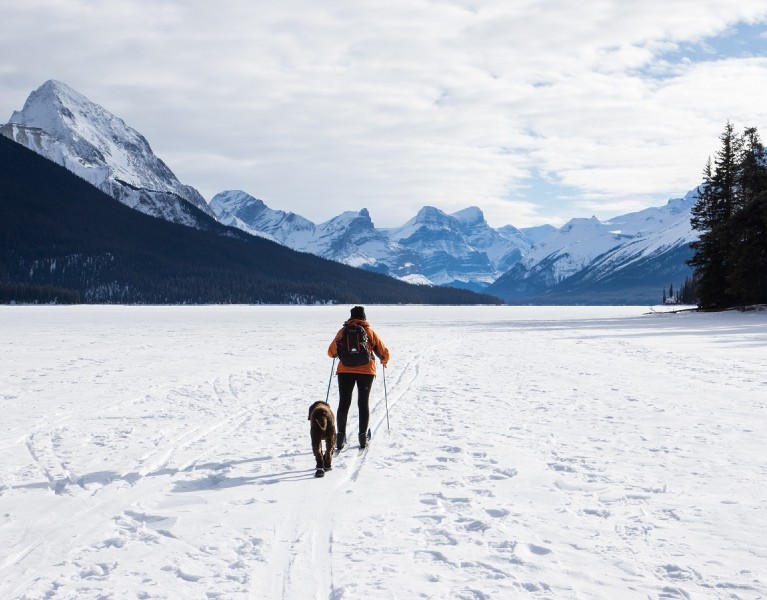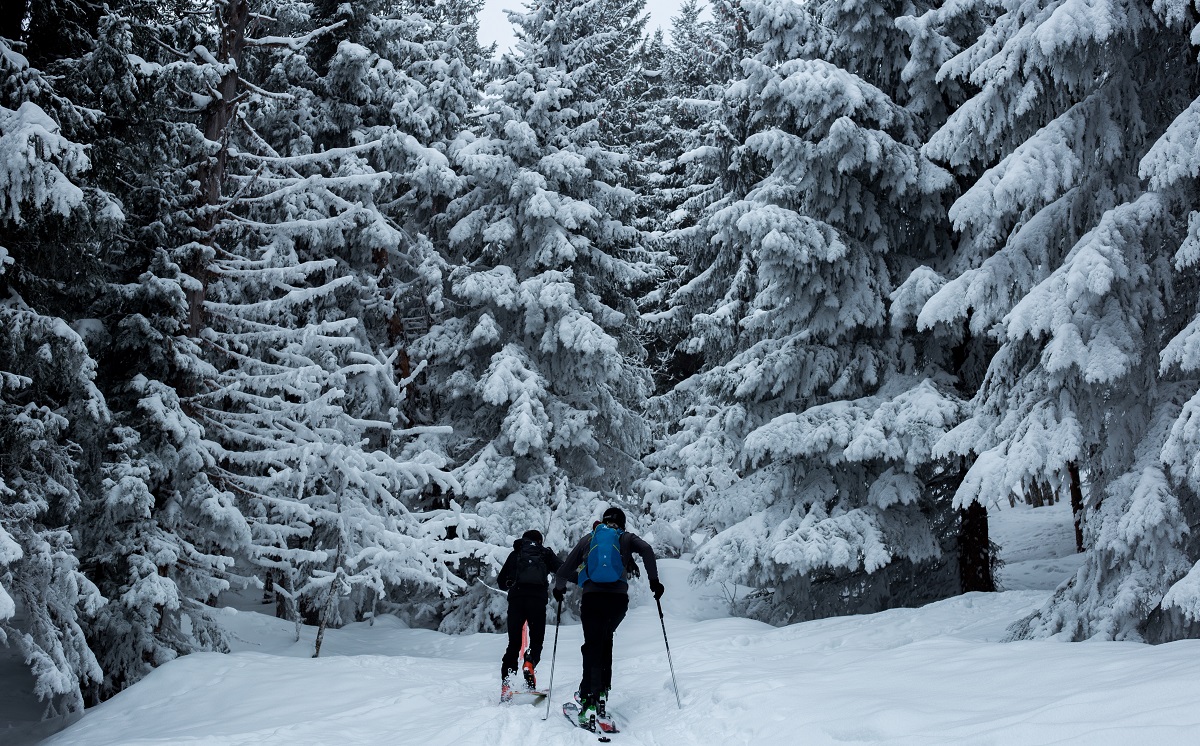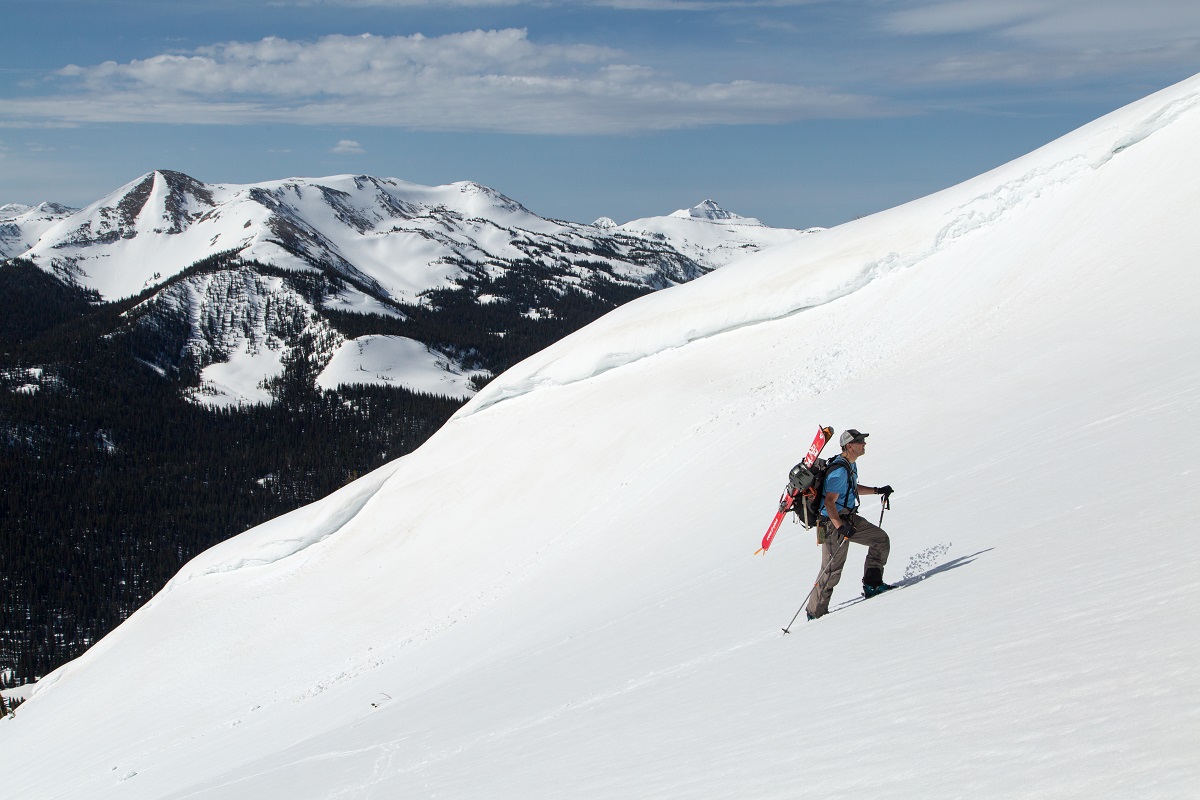- 1. Choose the Right Nordic Ski Design
- 1.1. "Classic" cross country skis
- 1.2. Touring skis
- 1.3. Skate skis
- 1.4. Telemark skis
- 1.5. Alpine touring skis
- 2. Get Equipped by a Pro
- 3. Get Outfitted Above the Ankles
- 3.1. 1. Use layers wisely
- 3.2. 2. Allow for a full range of motion of both top and bottom
- 3.3. 3. Invest in the best quality you can afford
- 4. Make the Most of Your Cross-Country Skiing
- 5. Some of the Top Nordic Ski Trails
- 5.1. Rendezvous Ski Trails
- 5.2. Cross Country Ski Headquarters
- 5.3. Sun Valley

The Low-Down on Basic Nordic Ski Styles
Table of Contents [Show]
What's the best cure for cabin fever when you live in snow country? That's what I asked myself when I got tired of playing Skyrim several years back and realized the holidays had shrunk my favorite lounge-around pants. I found the answer in Nordic (or "cross-country") skiing.
I grew up thinking of myself as a mogul-slayer, but since I live an hour away from the nearest alpine ski resort and the cost of lift tickets adds up, I wanted to focus on something I could do close to town, or even from my front door. The fewer steps to getting a workout, the better.
Mind you, I'm no lazy bum. I spend my fair-weather days kayaking, hiking, climbing, camping, and fly fishing. I bow hunt, which after a hard season tracking mule deer on snowshoes makes a girl justify a little slacking off once the season closes December 1. And as much as I love snowshoeing, I'm pretty much over it once I've hunted, harvested and packed out my winter's supply of meat. Nordic skiing is an entirely different way to experience the outdoors.
Choose the Right Nordic Ski Design
Before you pick up your first pair of cross-country skis, you'll want to decide which of the three basic classes are most appropriate to your local terrain and ambition.
"Classic" cross country skis
The modern take on old-school XC ski designs are still extremely popular, especially with beginners and those who want reasonable adaptability to available surface conditions and terrain. They're best for groomed trails, but they can handle a bit of powder and crud. Classic Nordic skis have a flexible, arched grippy midsection to help you keep traction without compromising your forward momentum, whether you're traversing flat or slightly uphill terrain.
I got my start with classic Nordic skis, and while I've rented other types for novelty, they're my favorite for looping around the local neighborhood park and soccer fields or for those times when I do get to jump on a chairlift or visit a dedicated cross-country ski destination.
Touring skis
If you like to get away from civilization, touring skis are ideal for less civilized terrain. They're broader than other cross-country styles to help you float over deeper snow, and more substantial to support aggressive, backcountry skiing.
You've got two basic types: Those with metal edges and those without. The former is best for ungroomed, deeper snow while the latter is more suitable to groomed, packed runs. If you decide your dog is turning into a wintertime couch potato, you never want skis with metal edges. Classic and touring skis are ideal for skijoring.
Skate skis
You'll need access to packed, groomed conditions for skate skis, but if speed's your thing, and you have a little bit of experience under your belt, this is the way to go. Skate skis are narrow and more rigid than their touring and classic XC cousins and built for a side-to-side, edge-reliant "push-off" motion rather than the smooth "stride-and-glide" action most people associate with Nordic skiing.
Telemark skis
You'll see more telemarkers on groomed mountains than any other type of non-Alpine ski, and that's because telemark ski systems are designed for steeper terrain. But they're just as suited to bailing into out-of-bounds powder.
Telemark skis are beefier than touring skis, and their bindings allow for greater vertical boot movement to allow for those sweeping turns required to traverse steep hills. These turns in telemark skiing also require strong knees, as telemarkers dip gracefully into a kneeling position to maneuver those turns.
Alpine touring skis
Not quite ready to give up on your fixed-binding downhill skis? Alpine touring skis bridge the chasm between XC and Alpine. Release the heel plate for rolling or uphill terrain, and lock back in for downhill runs and mogul fields. Alpine touring skis work well in all types of snow and are gaining traction (you know what I mean) with ski patrols and rescue teams.
Get Equipped by a Pro
Even within each class of XC or hybrid downhill ski, different characteristics influence its suitability and performance. Once you nail down your ski type, you have just as many options among bindings and boots.
Tip: decide what kind of performance socks you'll wear, and bring them with you when you shop for cross-country boots. I recommend medium-weight wool/synthetic blends, or straight-up Merino wool socks.
Find a reputable ski shop that lets you demo a few different skis. Take a few lessons, and once you've gained enough experience and context, start shopping for your first set. For all but the most confident, obsessive researchers, input from seasoned ski salespeople and instructors are the best way to match up the right equipment. Don't forget your ski poles!

Get Outfitted Above the Ankles
Before your first lesson or demo, invest in adventure clothing suitable for cross-country skiing. Ready for my bottom-line rules for any type of wintertime outdoor activities?
1. Use layers wisely
The more effort you expect to put into your day, the fewer layers you should wear, and you have to make those layers count. You'll perspire whether or not you're cutting uphill tracks or gliding over sun-sparkled snowfields, so you'll want moisture-wicking fleece durable Merino wool base layers to stay dry. If the word "wool" makes you itch, Merino will bring you around - it's lightweight and soft and keeps you warm even when it's wet. Perfect for a base layer.
Your next layer should have just enough loft to trap warmth, but not enough to retain moisture. On top of that? Windproof and water-resistant shell layers, and a compact down vest or jacket stuffed in a day pack... just in case. You'll want the extra layer to stay warm in case you decide to stop for a snack on a cold day.
If you opt for lined, skin-hugging pants with a bit of stretch, you can always stash your soft shell pants in your pack until you need it.
2. Allow for a full range of motion of both top and bottom
Your whole body's going to get a workout whether you're in an normal downhill skiing venture or trying out the new skate cross country skis. Your typical snow pants, fleece women's leggings, or (gasp) jeans will get mighty chafe-y mighty fast. All your layers should have articulated knees and elbows, and your pants should have gusseted crotches. If you can, find a shell or down jacket with an extra armpit panel - this aids breathability as well as movement.
3. Invest in the best quality you can afford
Well-made outdoor apparel always fits, feels, lasts, and performs better than entry-level or budget clothing. The right designs put seams where they won't chafe or ride up. Stitching and materials are far superior, lasting for several seasons of abuse and cleaning. Cheap performance clothing's breathability and water-resistance tend to degrade within a season or two, right about when you've gained enough skill to push yourself harder under more challenging conditions. That's why getting a top quality cross country ski pants pays out in the long run.
Make the Most of Your Cross-Country Skiing
I've already mentioned dog skijoring, but you'll find that XC skiing will open up new wintertime activities. In March, I'll go out to look for elk and deer antler sheds. When my friends go ice fishing and there's a layer of snow on the ice, I'll show up towing a sled full of hot adult beverages and treats. I'll sneak up on a nice, fat tom turkey, or bring my camera for fantastic wildlife photography. Animals aren't expecting predators to quietly glide into range as their instincts are attuned to footsteps.
And another thing. I make a few bucks on the side field-testing outdoor clothing and equipment from a variety of top brands, which is why you can trust the above advice. You can pretty much take my word for it that after putting a few KÜHL performance clothing pieces through the wringer, I've ponied up my own cash to round out my own wardrobe with their products and accessories.
After all, if we're going to pull ourselves away from our cozy winter dens, we want to make it fun even on the coldest days. Having the right gear and clothing keeps us motivated and excited about our favorite outdoor sports... and our post-holiday waistline workouts. So whether you're into classic cross country skiing, alpine skiing, skate skiing, or even ski jumping, check out some of these winter pants for men and winter pants for women.
Some of the Top Nordic Ski Trails
Nordic skiing is an extremely flexible sport, something you can do almost anywhere it snows. However, there are certain trails that offer an exceptional experience.
Check out Top 10 Cross Country Skiing Trails at These Hot Spots Happening in Utah.
Here are some of the top destinations in the U.S. for Nordic skiing:

Rendezvous Ski Trails
These trails in Montana, managed by the West Yellowstone Chamber of Commerce, is located in the beautiful Rocky Mountain region just west of Yellowstone National Park in the Gallatin National Forest. This is the site of the annual Yellowstone Ski Festival. This site, a favorite among Olympic athletes, has trails ranging from easy to challenging. It's also close to many wild areas suitable for backcountry skiing.
Cross Country Ski Headquarters
The Cross Country Ski Headquarters in Higgins Lake, Michigan, is a one-stop destination for everything ski-related. There are ski and other equipment rentals, ski instruction, and over 18 km of trails. Michigan is a popular cross-country skiing destination because of its mostly flat landscape and amazing scenery.
Sun Valley
Sun Valley is a resort in Idaho that offers over 40 km of Nordic ski trails for people of all abilities. You can rent snowshoes as well as skis. Sun Valley also has excellent dining, lodging, and shopping.
In the end, check out Why Bozeman is One of the West’s Best Ski Towns.
Featured image: Cross country skiing on the frozen Maligne Lake in Jasper, Canada. Photo by Jasper Guy.


